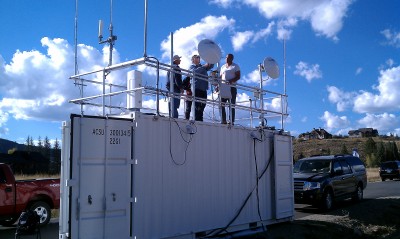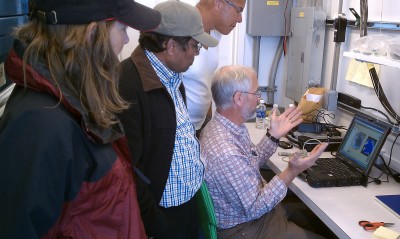Thursday, September 23
Published: 24 September 2010
We continued installing sensors on the ground radiation (GNDRAD), Sky Radiation (SKYRAD), Surface Meteorology (MET), Total Sky Imager (TSI) and Multi-filter Rotating Shadowband Radiometer (MFRSR). All sensors were installed and the task of connecting the myriad of cables has begun.
The Met tower has been tipped vertical now that all the sensors have been installed and is waiting to be raised to its final resting point. Once all functional tests and calibration checks are complete up it goes. The TSI, MFRSR, and Tracker all have power and are running but they still think they are at ANL as we have yet to update the latitude, longitude and elevation. The SKYRAD, GNDRAD and Met systems are all powered and running too.
The weather turned a bit colder prompting many of us to change from shorts and t-shirts to long pants, long sleeves and wind breakers with the exception of diehards Orr and Ritsche. A quick trip up to Christie Peak in the cold weather and strong winds to view the cement blocks where the AOS Van will reside had everyone heading quickly back to the truck.
Later in the day, the infrastructure for the ECOR system was installed in preparation for tomorrow’s install of the sensors. There are supposed to be thunderstorms tonight and some possible rain tomorrow as well. We are hoping it won’t be too difficult to install the ECOR in the rain and mud. The Ceilometer (VCeil) was repositioned to the roof of the General Purpose van after we decided that curious folks might want to peer into it even thought it is an eye-safe system.
Rich Coutler and Dick Eagan headed up to Storm Peak Labs for the day to finish installing the radio receiver there. It appeared to be working by the end of the day as the constant beeping of the radio finally (thankfully) turned to a solid tone indicating that connectivity was achieved.
We have daily reminders (visual evidence) of nighttime visitors such as bear and other four-legged creatures. The numerous daytime walkers and joggers validate that it’s not just our imaginations. Such happenings remind us of the remote and complex nature of this deployment, at least before the ensuing mass of skiers descend upon the area.


The ARM Climate Research Facility is a DOE Office of Science user facility. The ARM Facility is operated by nine DOE national laboratories, including .
Keep up with the Atmospheric Observer
Updates on ARM news, events, and opportunities delivered to your inbox
ARM User Profile
ARM welcomes users from all institutions and nations. A free ARM user account is needed to access ARM data.


















